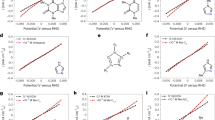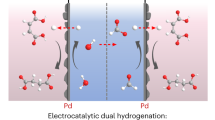Abstract
CATHODIZING an equilibrium Pd/H/H2 electrode (25° C.: 1 atm. hydrogen: zero volt potential with respect to a Pt/H/H2 reference in the same solution) further increases its hydrogen content (H/Pd, atomic ratio) and its corresponding hydride vapour pressure p. These increases are reflected as a component of overvoltage (volts) given1–3, the symbols η2 or ηd (termed1,3 the diffusion or hydride overvoltage) and related to p by η2 = 0.029 log p. The large capacity of palladium for hydrogen has enabled η2 to be obtained by extrapolation, back to zero time, of the increase of electrode potential, E, which follows interruption of cathodization, using established relationships between E, p and H/Pd (refs. 1–3). From such measurements it has been established1,3–5 for surfaces active for rapid equilibration with hydrogen molecules dissolved in solution that at current densities i less than 0.040 amp. cm.−2 the retarding kinetic step maintaining H/Pd in excess of its equilibrium value (1 atm. hydrogen: 25° C.) is the slow diffusion from the cathode of hydrogen molecules formed during electrolysis. Under these conditions, η2 is related to i by:  where under conditions of vigorous stirring i0 ∼ 3 m.amp. cm.−2. The observation1–3 that η2 attains an almost constant value for i greater than 0.040 amp. cm.−2, when hydrogen is evolved as bubbles, has been associated1 with either critical supersaturation of the diffusion layer with dissolved molecules or saturation of chemisorption sites. Experiments reported here appear to eliminate the latter possibility.
where under conditions of vigorous stirring i0 ∼ 3 m.amp. cm.−2. The observation1–3 that η2 attains an almost constant value for i greater than 0.040 amp. cm.−2, when hydrogen is evolved as bubbles, has been associated1 with either critical supersaturation of the diffusion layer with dissolved molecules or saturation of chemisorption sites. Experiments reported here appear to eliminate the latter possibility.
This is a preview of subscription content, access via your institution
Access options
Subscribe to this journal
Receive 51 print issues and online access
$199.00 per year
only $3.90 per issue
Buy this article
- Purchase on Springer Link
- Instant access to full article PDF
Prices may be subject to local taxes which are calculated during checkout
Similar content being viewed by others
References
Clamroth, R., and Knorr, C. A., Z. Elektrochem., 57, 399 (1953).
Frumkin, A., and Aladjalova, N., Acta Physicochim. U.R.S.S., 19, 1 (1944).
Lewis, F. A., Platinum Metals Rev. (in the press). Barton, J. C., and Lewis, F. A. (unpublished work).
Kandler, L., Knorr, C. A., and Schwitzer, E., Z. physik. Chem., Leipzig, A, 180, 281 (1937).
Knorr, C. A., Z. Elektrochem., 59, 647 (1955).
Tverdovskii, I.P., and Stetsenko, A.I., Doklady Akad. Nauk, S.S.S.R., 84, 997 (1952).
Carson, A. W., Flanagan, T. B., and Lewis, F. A., Trans. Farad. Soc., 56, 363, 1311 (1960).
Barton, J. C., and Lewis, F. A., Trans. Farad. Soc. (in the press).
Philpott, J. E., Platinum Metals Rev., 4, 12 (1960).
Author information
Authors and Affiliations
Rights and permissions
About this article
Cite this article
BARTON, J., LEWIS, F. Hydrogen Overvoltage at Cathodes of 77 per cent Palladium and 23 per cent Rhodium. Nature 192, 549–550 (1961). https://doi.org/10.1038/192549a0
Issue Date:
DOI: https://doi.org/10.1038/192549a0
This article is cited by
-
Cinematographic study of the evolution of hydrogen bubbles during overpotential measurements
Die Naturwissenschaften (1964)
Comments
By submitting a comment you agree to abide by our Terms and Community Guidelines. If you find something abusive or that does not comply with our terms or guidelines please flag it as inappropriate.



